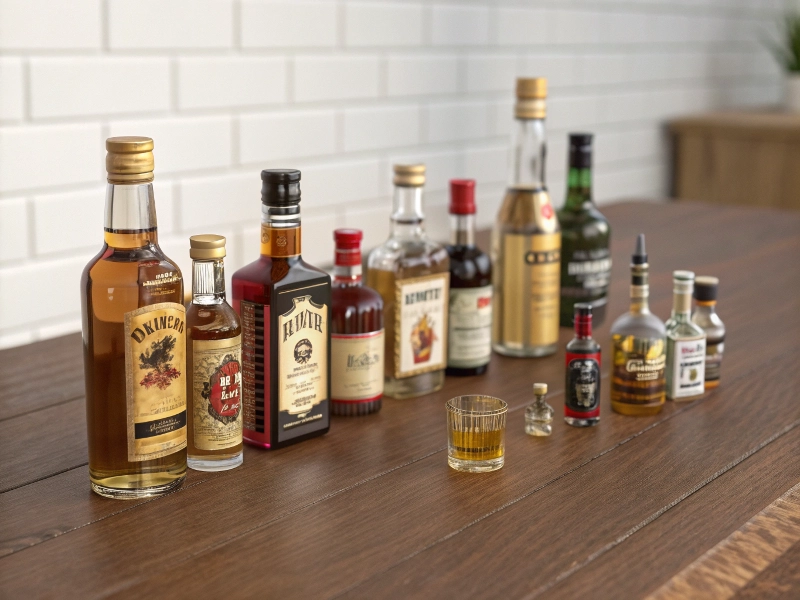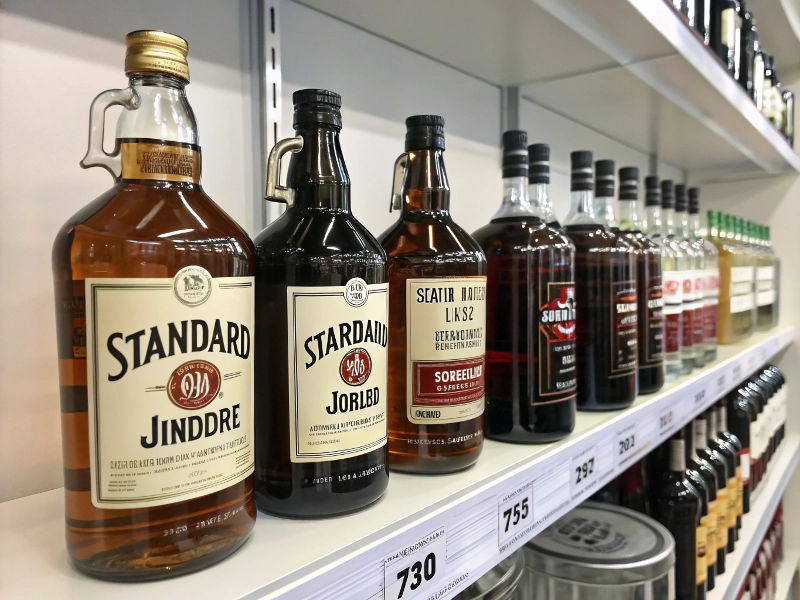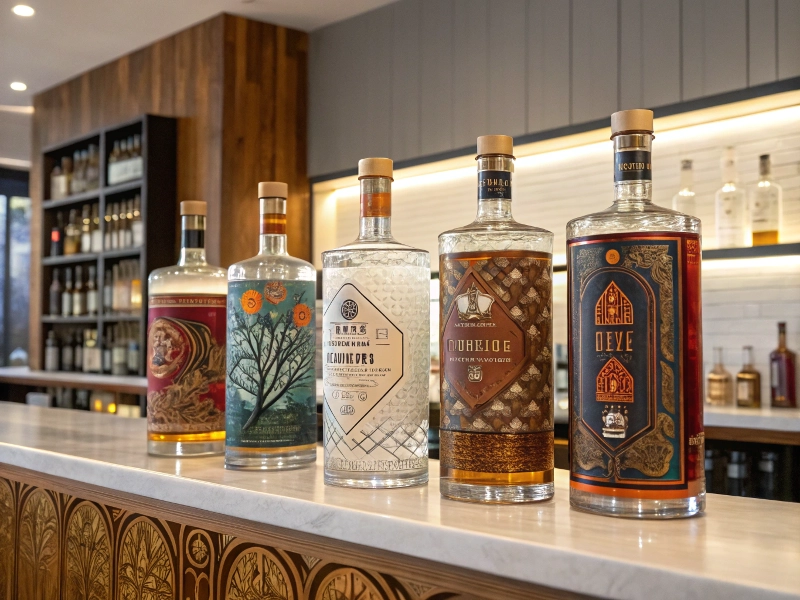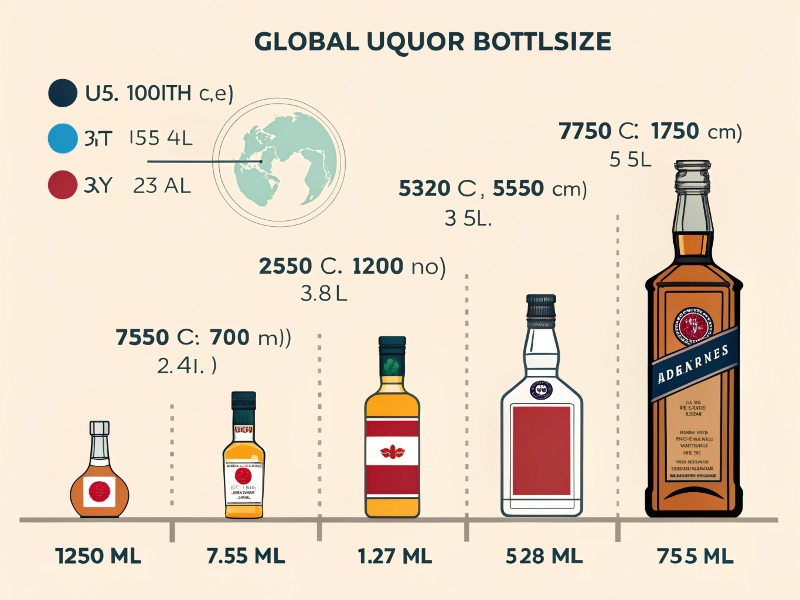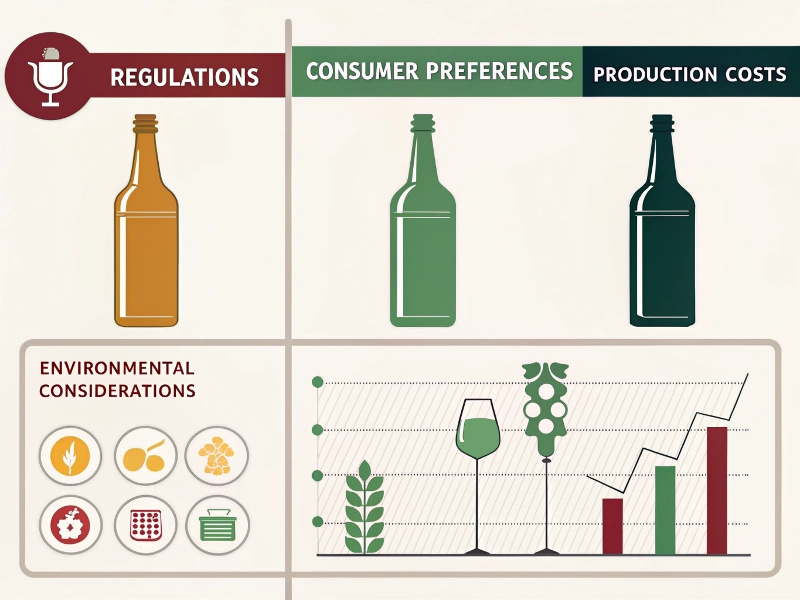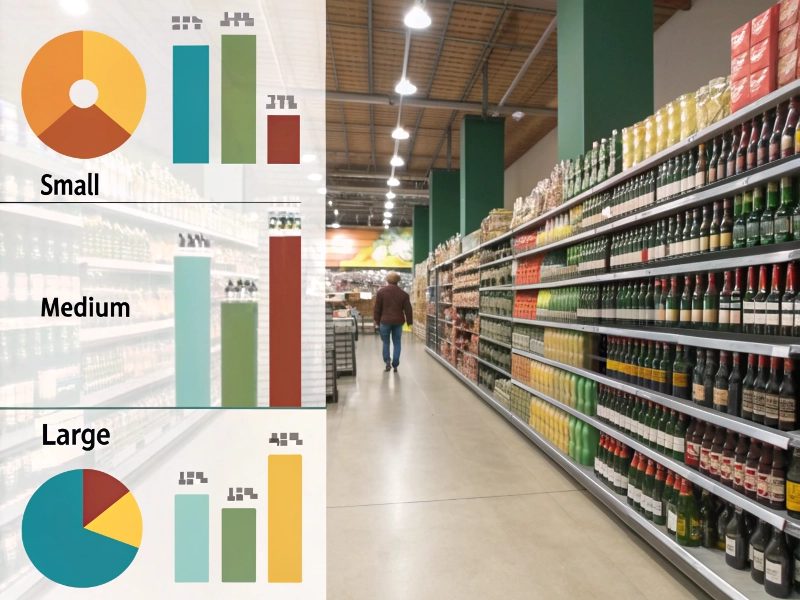Introduction
Navigating liquor bottle sizes can be confusing, with variations across spirits, regions, and packaging driven by regulations, consumer habits, and cultural traditions. From 50 ml nips to 4.5 L rehoboams, these differences impact cocktail planning, bar stocking, and branding, posing challenges for home mixologists, bartenders, and distillers. Misjudging bottle sizes risks recipe errors, higher costs, or missed opportunities for eco-friendly packaging.
What are liquor bottle sizes, and how can you navigate their variations to make informed choices? This central problem stems from the complex mix of regulatory standards, market demands, and design choices.
Liquor bottle sizes are shaped by regulations , consumer preferences , and brand positioning. The U.S. uses 750 ml , Europe favors 700 ml , and Japan prefers 720 ml for sake. Larger bottles like 1.75 L handles cut packaging waste by 20-30% per ounce, while unique designs boost brand identity by 15%, per a 2024 Beverage Dynamics study._cupertino
This comprehensive guide clarifies liquor bottle sizes and liquid measurements, offering practical insights for consumers, bartenders, distillers, and eco-conscious users. Key questions include:
- What are the standard liquor bottle sizes, their measurements, and historical origins?
- What are the unique sizes and designs of different spirit types?
- How do bottle sizes vary across global markets, especially Europe’s 700 ml standard?
- Why do these size differences exist?
- How do consumer preferences and brand positioning influence bottle size choices?
What Are the Standard Liquor Bottle Sizes and Their Historical Origins?
Understanding liquor bottle sizes is essential for choosing the right bottle for cocktails, bars, or branding. Liquor bottle sizes span a wide range, shaped by historical standards and modern regulations.
Liquid Measurements and Standard Shots
Liquid measurements are key to understanding bottle capacities:
- Standard Shot: In the U.S., a shot is typically 1.5 oz (44.36 ml), though Utah defines it as 1 oz (29.57 ml). No national standard exists, so bars may pour 1.25-1.5 oz (37-44 ml). A double shot is 3 oz (88.72 ml).
- Unit Conversions:
- 1 ml = 0.0338 oz
- 1 oz = 29.57 ml
- 1 L = 33.8 oz
- 1 quart = 946 ml (32 oz)
- 1 gallon = 3.785 L
- Practical Use: Shot counts (e.g., 750 ml = 17 shots at 1.5 oz) help with recipe planning and bar stocking, per a 2024 bar survey.
Standard Sizes and Shot Counts
Liquor bottle sizes span a range, with shot counts for a 1.5 oz (44.36 ml) pour, per a 2024 Beverage Dynamics study:
| Size (ml) | Ounces | Common Name | Shots (1.5 oz) |
|---|---|---|---|
| 50 ml | 1.7 oz | Nip/Airplane Bottle | 1 |
| 100 ml | 3.4 oz | Quarter-Pint | 2 |
| 200 ml | 6.8 oz | Half-Pint | 4 |
| 375 ml | 12.7 oz | Half Bottle/Pint | 8 |
| 700 ml | 23.7 oz | EU Fifth | 15 |
| 750 ml | 25.36 oz | U.S. Fifth | 17 |
| 1 L | 33.8 oz | Liter | 22 |
| 1.5 L | 50.7 oz | Magnum | 34 |
| 1.75 L | 59.2 oz | Handle | 39 |
| 3 L | 101.4 oz | Jeroboam/Double Magnum | 67 |
| 4.5 L | 152.2 oz | Rehoboam | 101 |
Common Terms and Their Size Equivalents
Historical names reflect older measurement systems:
- Fifth (750 ml, 25.36 oz): Originated in the 19th-century U.S. as one-fifth of a gallon (3.78 L) for tax purposes, still used despite metric adoption.
- Pint (375 ml, 12.7 oz): In U.S. liquor, smaller than a beer pint (473 ml in U.S., 568 ml in UK).
- Handle (1.75 L, 59.2 oz): Named for its handle, also called half gallon.
- Half-Pint (200 ml, 6.8 oz): Popular during Prohibition for concealability.
- Magnum (1.5 L, 50.7 oz): Also used for 1.75 L in some liquor contexts, from wine terminology.
- Canadian Terms: Mouse (200 ml), Mickey (375 ml), Forty/Two-Six (750 ml), Sixty (1.75 L), Texas Mickey (3 L), rooted in regional slang.
- Rehoboam (4.5 L, 152.2 oz): Named after a biblical king, for grand events.
Recent Changes in Liquor Bottle Sizes
Shrinkflation, namely product sizes shrinking while prices stay constant or increase, is a growing trend in the liquor industry.
Specific Situation: Capacity decreases while appearance remains unchanged. Some regions are approving new bottle sizes, allowing suppliers to reduce bottle capacity while maintaining the same bottle appearance. Additionally, major brands are pushing for a shift in liquor bottles from 750 milliliters to 700 milliliters. This means consumers receive 50 milliliters less alcohol for the same price.
Reasons Behind: The European Union (EU) legislation mandates a standard spirits bottle capacity of 700 milliliters. To reduce costs and streamline global distribution stock-keeping units (SKUs), major global brands such as Hennessy, Jack Daniel’s, and Evan’s are adopting the EU’s 700 milliliter standard. Using a single bottle type in international markets enhances operational efficiency.
Market Trend: The current “new changes” indicate that the global spirits market is trending toward adopting the 700 milliliter European standard. This trend is even evident in markets like the United States and Canada, which traditionally preferred 750 milliliter bottles. This marks a shift in certain markets from the 750 milliliter “standard” to smaller sizes.
What Are the Unique Sizes and Designs of Different Spirit Types?
Each spirit type—vodka, whiskey, rum, gin, tequila, and brandy—has distinct sizes and designs that enhance functionality and brand identity.
Specific Spirit Types
The table below details their sizes, designs, and brand examples, per a 2024 Beverage Dynamics study:
| Spirit Type | Common Sizes (ml) | Bottle Design | Brand Example |
|---|---|---|---|
| Vodka | 50, 100, 200, 375, 500, 700 (Europe), 750 (U.S.), 1000 | Sleek, tall, often frosted for purity | Absolut 500 ml, Suntory 200 ml (Asia gifting) |
| Whiskey | 375, 473 (pint), 500, 750, 1000 | Square or round with ornate labels; Boston round for Scottish brands | Glenfiddich 500 ml single malt |
| Rum | 50, 100, 200, 375, 750, 1750 | Squat, wide-base with vibrant labels | Bacardi 1750 ml |
| Gin | 473 (pint), 500, 750, 1000 | Tall, refined, often square or frosted long-neck | Bombay Sapphire 500 ml square bottle |
| Tequila | 50, 375, 750 | Complex, artistic shapes with decorative elements | Patrón 750 ml |
| Brandy/Cognac | 50, 200, 375, 750 | Wide-base with decorative stoppers, luxurious packaging | Hennessy 375 ml |
Common Bottle Designs
These designs enhance functionality and appeal:
- Round Liquor Bottle: Traditional, popular; Oslo/Nordic bottles are comfortable to hold and easy to label.
- Square Liquor Bottle: Unique, reduces breakage during transport; common in 375 ml, 500 ml, 750 ml.
- Rectangular Glass Bottle: Flat, slim with straight edges for storage; 500 ml, 700 ml common for whiskey and gin.
- Long-Neck Spirit Bottle: Sleek, protects against UV; frosted for vodka’s purity.
- Boston Round Liquor Bottle: Cylindrical with short, curved shoulders, favored by Scottish whiskey.
- Punt Base Bottle: Concave base for stability, often with luxurious corks.
- Swing Top Bottle: Sealed for flavor, retro charm for craft appeal.
A London gin distillery boosted sales by 15% with a square 500 ml bottle. Partner with manufacturers for custom bottle designs to elevate your brand. “Bottle designs define a spirit’s identity,” says Maria Lopez, Packaging Designer.
“A square 500 ml gin bottle caught my eye—it screamed quality!” — Tom Wu, Craft Spirits Enthusiast
How Do Bottle Sizes Vary Across Global Markets, Especially Europe’s 700 ml Standard?
Bottle size variations reflect a complex interplay of regulations, cultural preferences, and market demands across global markets.
North America
- U.S. Standard: 750 ml (25.36 oz, 17 shots), a fifth, dominates due to historical gallon-based measurements.
- Additional Sizes: Includes 50 ml nips, 100 ml quarter-pints, 200 ml half-pints, 375 ml pints, 1 L, and 1.75 L handles (39 shots), with TTB’s 2025 updates adding 187 ml to 3.75 L, per regulatory data.
- Shot Variations: Standard 1.5 oz (44.36 ml) shots, except Utah’s 1 oz (29.57 ml), with bars pouring 1.25-1.5 oz.
Europe
- EU Standard: 700 ml (23.7 oz, 15 shots), set in 1990, unifies trade and divides into 25 ml or 35 ml shots.
- Other Sizes: 200 ml, 350 ml, 500 ml, and 1 L, with 500 ml popular for premium spirits like Glenfiddich.
- Unique Constraint: 250 ml bottles are not permitted, unlike the U.S.
Asia
- Small Sizes: 200-375 ml bottles are favored for gifting, with Suntory’s 200 ml whiskey leading in Japan.
- Sake Standard: 720 ml reflects cultural aesthetics, per a 2024 market report.
- Market Share: 50 ml mini-bottles and 500-700 ml bottles are significant for travel and premium markets.
South America
- Large Sizes: 1-1.75 L bottles dominate for family gatherings and events like Brazil’s Carnival.
- Premium Market: 750 ml used for high-end products, balancing cost and quality.
- Cultural Fit: Large bottles align with social drinking traditions.
Other Regions
- Canada/Mexico: Both 700 ml and 750 ml are sold, offering flexibility.
- Australia: Prefers 700 ml for spirits, aligning with EU standards.
Global bottle sizes are shaped by a diverse blend of historical, regulatory, and cultural factors, creating unique market standards.
Why Do These Size Differences Exist?
Bottle size differences stem from regulatory, cultural, and economic factors shaping global markets.
Regulatory Standards
- EU Regulations: The 1990 700 ml standard ensures trade unity and shot divisibility (25 ml, 35 ml).
- U.S. TTB: 2025 updates allow 187 ml to 3.75 L, ensuring non-misleading designs, per regulatory data.
- Regional Variations: Australia’s 700 ml and Japan’s 720 ml sake bottles reflect local laws.
Consumer Needs
- Convenience: 50 ml nips (Suntory’s 50 ml whiskey) cater to travel and sampling.
- Social Sharing: 750 ml (Bordeaux’s 750 ml wine) suits dining and sharing.
- Value: 1-1.75 L bottles offer cost savings, popular in South America.
Production and Environmental Factors
- Cost Efficiency: Standardized 700 ml bottles reduce production costs.
- Sustainability: 1.75 L bottles cut 20-30% waste per ounce, per a 2024 sustainability report.
- Cultural Influence: Japan’s 720 ml sake bottles align with aesthetic traditions.
| Factor | Example Size | Reason |
|---|---|---|
| Regulations | 700 ml spirits | EU trade unity |
| Consumer Preferences | 50 ml spirits | Travel convenience |
| Production Costs | 700 ml standard | Lowers expenses |
| Environmental | 1.75 L spirits | 20-30% less waste |
Bottle size differences reflect a strategic balance of practicality, culture, and cost, shaping global liquor markets.
How Do Consumer Preferences and Brand Positioning Influence Bottle Size Choices?
Consumer preferences and brand positioning drive bottle size choices, balancing practicality with market appeal.
Consumer Preferences
- Convenience: 50-200 ml bottles (Suntory’s 200 ml whiskey) are ideal for travel and gifting in Asia.
- Social Occasions: 750 ml (17 shots at 1.5 oz) suits sharing, perfect for dining.
- Value: 1-1.75 L bottles offer cost savings for South American gatherings.
Regional Preferences
- North America: 750 ml is standard; 1-1.75 L thrives in supermarkets.
- Europe: 700 ml dominates; 500 ml for premium spirits like Glenfiddich.
- Asia: 200-375 ml for gifting; 720 ml for sake, per cultural traditions.
- South America: 1-1.75 L for events like Brazil’s Carnival.
Brand Positioning
-
Premium Brands: 375-500 ml bottles (Hennessy’s 375 ml cognac) signal exclusivity.
-
Mass-Market Brands: 1-1.75 L bottles (Bacardi’s 1.75 L rum) emphasize value.
-
Innovative Designs: Swing top and punt base bottles boost brand identity. A Paris bartender prefers 700 ml bottles for efficient shot pouring. Choose 200-375 ml for gifting or 1.75 L for events to align with consumer needs.
-
Small bottles suit travel: 50-200 ml for gifting, like Suntory’s 200 ml.
-
Standard bottles for sharing: 750 ml (17 shots) balances variety and waste.
-
Large bottles offer value: 1-1.75 L for cost savings, ideal for bars.
-
Custom designs enhance branding: 500 ml square bottles boost brand visibility by 15%.
Consumer preferences and brand strategies shape bottle size choices to maximize appeal and functionality.
Conclusion
This comprehensive guide to liquor bottle sizes unravels the standards, measurements, designs, and influences shaping alcohol packaging, empowering you to make strategic choices. From 50 ml nips to 4.5 L rehoboams, sizes like the U.S.’s 750 ml fifth , Europe’s 700 ml , and Japan’s 720 ml sake bottles reflect regulations, consumer preferences, and brand positioning. Larger bottles like 1.75 L handles cut packaging waste by 20-30% per ounce, while designs like square 500 ml gin bottles boost brand identity by 15%, per a 2024 Beverage Dynamics study. “Bottle sizes balance practicality and market strategy,” says Maria Lopez, Packaging Designer.


